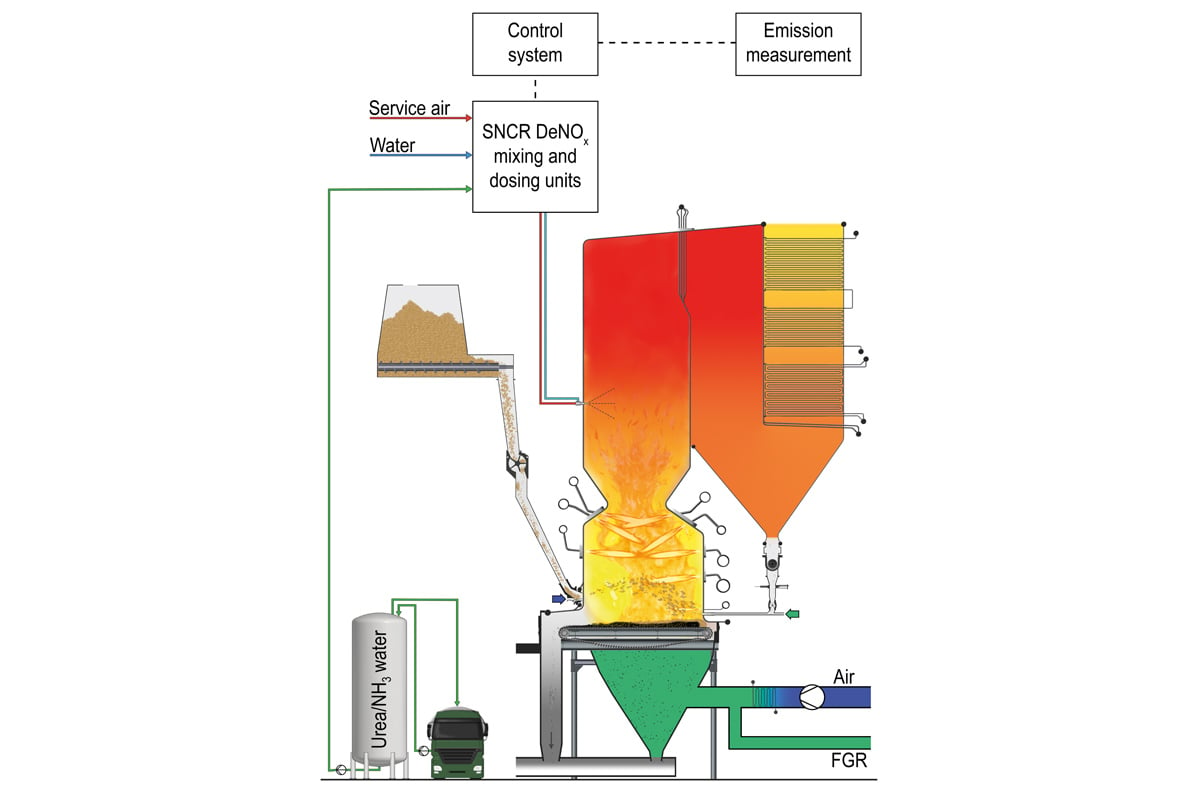How to reduce NOx emissions with Standard Selective Non-Catalytic Reduction
by Aalborg Energie Technik a/s on Feb 15, 2023 1:44:40 PM

In addition to the various ways that boiler plant operators can use primary techniques to prevent or minimise the formation of NOx, there are also a number of secondary techniques that can reduce the NOx that has already been created.
The methods for secondary reduction are Standard or Advanced Selective Non-Catalytic Reduction (SNCR), and Selective Catalytic Reduction (SCR). Some boiler operators also use a hybrid of SNCR and SCR.
All of these methods involve the introduction of a reducing agent like ammonia or urea. The various methods of secondary reduction techniques each have their own advantages and disadvantages. In this article, we look at the plusses and minuses of Standard SNCR.
Standard Selective Non-Catalytic Reduction
Standard SNCR involves the selective reduction of NOx to nitrogen through a reaction with a reducing agent like ammonia or urea at 850 to 1090°C.
For transport and storage safety reasons, ammonia water is usually supplied with a maximum concentration of 25%, whereas the urea solution used in secondary reduction techniques is typically supplied at around 45% concentration. It can also be produced on-site from solid urea.
To optimise the utilisation of the reducing agent and ensure minimal NH3 slip emissions, it’s essential to have an effective and uniform mix of the flue gas and the reducing agent. Diluting the urea or ammonia water with demineralised water prior to injection helps distribute the reducing agent over a larger area and reach deeper into the post-combustion chamber at the point of injection. Uniform distribution is further facilitated by the addition of compressed air at the injection nozzles, thereby atomising the reducing agent solution.
A Standard SNCR solution is made with one injection level in the furnace. A standalone controller can implement the injection based on an online NOx emission measurement.
Smaller plants, however, might not have online NOx measurements and will instead utilise a premixed reducing agent stored in plastic tanks.
When introducing ammonia or urea, it’s critical to consider reaction times. Ammonia water generally has a short reaction time, whereas urea takes longer to react. It’s also important to ensure the right temperature. If the NOx reducing agent is injected at too low a temperature, the NOx will not react with ammonia and high NH3 emissions will occur in the flue gas. If the NOx reducing agent is injected at too high a temperature, the ammonia will react with O2 rather than NOx, and the resulting NOx reductions will be minimal.
A potential by-product in the flue gas can be unreacted ammonia, called ammonia slip. Methods to minimise ammonia (NH3) slips in a standard AET SNCR system can be many, e.g.:
- Optimise or upgrade the primary NOx reduction methods
- Reposition some of the lances or all lances to a higher furnace temperature
- Some of the lances which are in a colder furnace temperature can be angled towards a higher furnace temperature (might require new injection lances)
- There might be a difference in the NOx formation across the furnace area, so the amount of injected ammonia might need to be individually adjusted to each lance across the furnace area
- Change of the NOx reducing agent
- Use of Advanced AET SNCR system
- Contact AET Aftermarket, Nicolai Møller at nim@aet.dk or +45 3093 3289.
Advantages of Standard SNCR:
- Typical NOx reduction of 25 to 70%
- Easy and simple integration
- High reliability
- Low maintenance costs
- Compact solution
- Low CAPEX compared to SCR.
Disadvantages of Standard SNCR:
- Requires space for reducing agent storage
- High water consumption if poor atomising of reducing agent
- Higher consumption of reducing agent than SCR.
Standard SNCR is just one of the secondary techniques that companies can use to reduce their NOx emissions. Be sure to read about the pros and cons of Advanced SNCR, Selective Catalytic Reduction and a hybrid approach before deciding what is right for you. You can also learn much more about NOx reduction in our comprehensive e-book.
Do you need help with your project?
Our experts are ready to assist you. Fill out the form below and we will get back to you as soon as possible.
Contact us

David Kjølby Krøger


